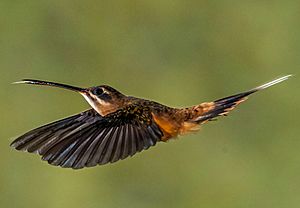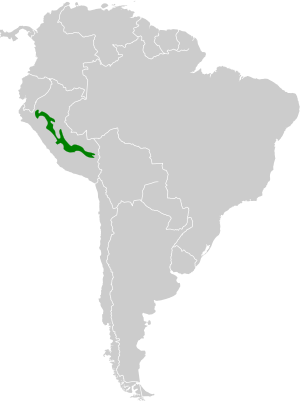Koepcke's hermit facts for kids
Quick facts for kids Koepcke's hermit |
|
|---|---|
 |
|
| Conservation status | |
| Scientific classification | |
| Genus: |
Phaethornis
|
| Species: |
koepckeae
|
 |
|
The Koepcke's hermit (Phaethornis koepckeae) is a special type of hummingbird that lives only in Peru. It's part of the Trochilidae family, which is the hummingbird family. This small bird was first described in 1977.
Contents
About the Koepcke's Hermit
The Koepcke's hermit is a unique bird. It is the only species in its group, meaning it doesn't have different subspecies. It is closely related to another hummingbird called the needle-billed hermit. They are like "sister species" because they share a common ancestor.
What Does It Look Like?
The Koepcke's hermit is a small bird, about 14 to 15 centimeters (5.5 to 5.9 inches) long. Males weigh around 4.7 to 5.8 grams, and females are a bit lighter, weighing 4.5 to 4.9 grams.
Here are some of its features:
- It has a mostly straight beak, which is unusual for a hermit hummingbird.
- Its head is blackish with a green shine.
- The back of its neck is a shiny greenish-bronze.
- Its back is a glossy bronze color.
- The rump (the area above the tail) is reddish-brown.
- The tail is mostly dark glossy green. The two innermost tail feathers are longer than the others and have white tips. The other tail feathers have broad, buffy-reddish tips.
- Its face has a black "mask" pattern. This mask is outlined by thin white stripes.
- The chin and throat are white.
- The middle of its chest is a pale reddish-brown, with grayer sides.
- Its belly and flanks (sides) are a rich reddish-brown color.
Where Does It Live?
The Koepcke's hermit lives on the eastern slopes of the Peruvian Andes mountains. You can find it from just south of the Marañón River in the Amazonas region, all the way south to central Madre de Dios.
It prefers to live at elevations between 450 and 1,300 meters (1,476 and 4,265 feet) above sea level. Its home is in the lower parts of tall, evergreen forests and humid montane forests (mountain forests). It usually avoids areas where forests have been cut down and are regrowing.
Behavior and Life
Feeding Habits
Like other hermit hummingbirds, the Koepcke's hermit is thought to be a "trap-line" feeder. This means it flies along a regular path, visiting many different flowering plants to drink their sweet nectar. It also eats small arthropods, which are tiny creatures like insects or spiders.
Reproduction and Nesting
Scientists are still learning about the exact breeding season for the Koepcke's hermit. We do know that it builds a special nest. The nest is shaped like a cone and hangs from the underside of a drooping leaf tip. This helps keep the nest hidden and safe.
Vocalization
The Koepcke's hermit has a distinct song. It sounds like a clear, buzzing series of short notes, often described as "b'zee b'zee b'zee." Its calls include a ringing, rising sound like "tchwee" or "tchwing." It also makes a series of high notes that go down in pitch and get faster.
Conservation Status
The IUCN (International Union for Conservation of Nature) has listed the Koepcke's hermit as "Near Threatened." This means it could become endangered in the future if its population continues to decline.
It is estimated that there are only between 6,000 and 15,000 adult Koepcke's hermits left in the wild. Their numbers are going down. The main threat to this bird is rapid deforestation (the clearing of forests) in the areas where it lives.
See also
 In Spanish: Ermitaño de Koepcke para niños
In Spanish: Ermitaño de Koepcke para niños


